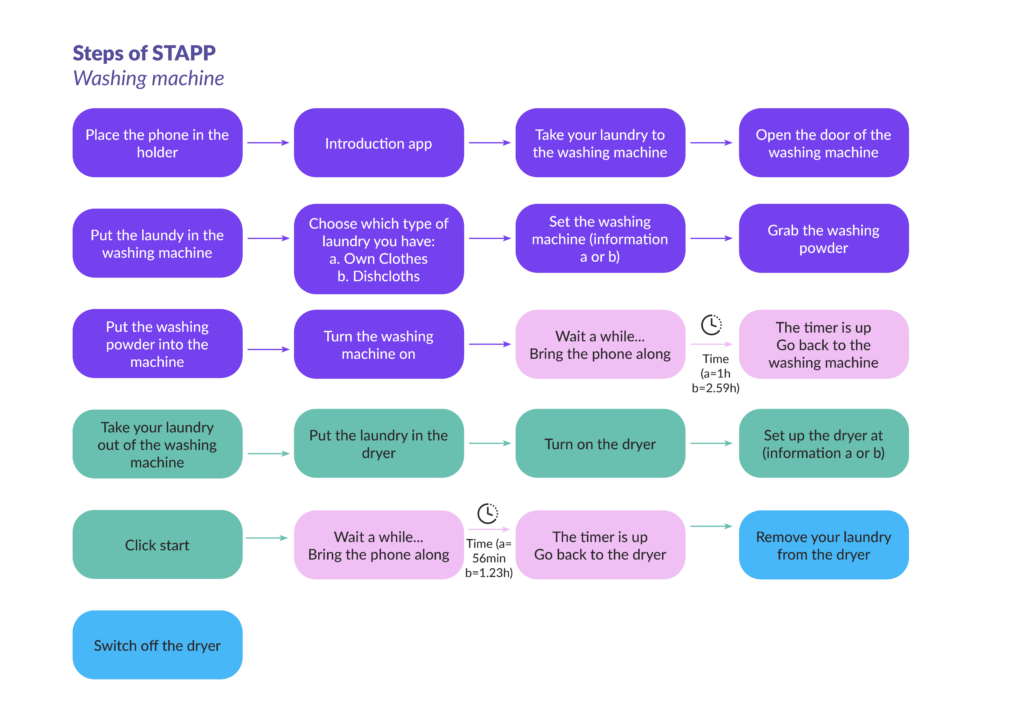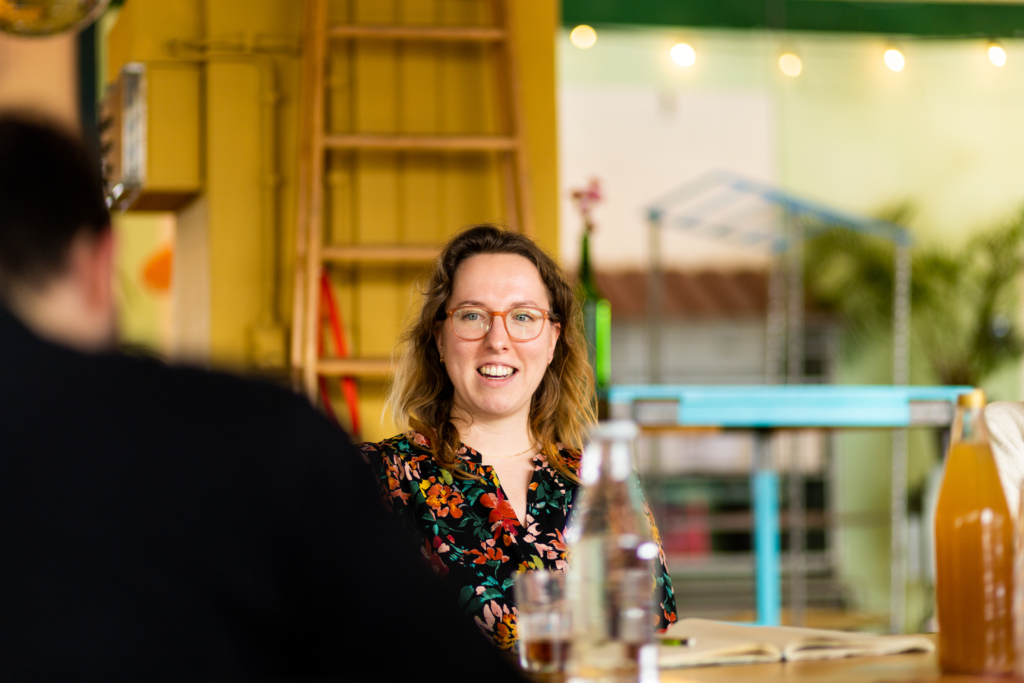Sanne Beijer and Fenna Dam present their CHI 2024 case study, entitled “STAPP: Designing a Tool for People with Korsakoff’s Syndrome to Re-learn Daily Activities Step by Step“

What’s your name?
Hi, we are Sanne Beijer and Fenna Dam!
Citation:
Sanne Beijer, Fenna Dam, Maarten Houben, and Rens Brankaert. 2024. STAPP: Designing a Tool for People with Korsakoff’s Syndrome to Re-learn Daily Activities Step by Step. In Extended Abstracts of the CHI Conference on Human Factors in Computing Systems (CHI EA ’24), May 11–16, 2024, Honolulu, HI, USA. ACM, New York, NY, USA, 7 pages. https://doi.org/10. 1145/3613905.3637119
TL;DR (if you had to describe this work in one sentence, what would you tell someone?):
We developed an application (STAPP) for people with Korsakoff Syndrome to re-learn daily activities step by step and perform tasks independently. We aim to increase the autonomy of people with Korsakoff Syndrome who need lifelong assistance.
What problem is this research addressing, and why does it matter?
Korsakoff Syndrome is a brain disorder predominantly caused by thiamine (Vitamin B1) deficiency that can be caused by malnutrition after alcohol abuse. However, other causes of Korsakoff Syndrome are known. The Syndrome can severely impair brain functioning, resulting in challenges that affect daily life. These challenges mean that making coffee (see cover image) or doing laundry becomes difficult.
Step-by-step learning has successfully been used as a method to re-learn activities of daily living. However, this method requires a lot of time and effort from formal caregivers who only sometimes have the time due to healthcare challenges (e.g., shortage of staff, higher workloads).
Interactive technologies provide novel opportunities to support people with Korsakoff Syndrome and their caregivers. Additionally, increasing autonomy for people with Korsakoff Syndrome may improve quality of life and reduce the pressure on care tasks.
How did you approach this problem?
The project was a collaborative effort of Pleyade (a Dutch care organization) and its innovation team in which the Eindhoven University of Technology partakes. Under the guidance of a professional designer (Fenna) and researcher (Sanne), an iterative and participatory process has been conducted for approximately a year. Fenna often visited one specific location of the care ward and gathered information about the formal caregivers and residents with Korsakoff Syndrome. Together with experts and residents, Fenna defined the design question, organized co-creation sessions, and discussed concept sketches. These activities led to the development of STAPP, an interactive digital application for smartphones. The application supports a person to complete multistep activities, such as making coffee and doing laundry, that contribute to someone’s independence. The two activities are split up into small, actionable steps and translated into videos with corresponding audio assignments.
We evaluated the experience of STAPP over three weeks with one resident and several formal caregivers. We relied on observations, field notes, and reflections to capture the care perspective on the benefits of STAPP for people with Korsakoff.

What were your key findings?
We learned three main lessons:
1. Assistive technology can help with increasing autonomy.
Formal caregivers saw an added value in increasing autonomy through stepwise guidance and empowering residents to do tasks individually. Additionally, the participating resident could make coffee without the help of his formal caregiver.
2. Relying on the digital skills of formal caregivers.
Even though the caregivers saw an added value of autonomy, only two caregivers used the application. The integration was complex because of:
- Insecurity of formal caregivers’ digital skillset.
- Concerns regarding the lack of in-person support.
- There is a fear that technology might take over enjoyable social activities.
- Formal caregivers want to stay close to the resident while using the app.
- Formal caregivers are the initiators of interactions with technology.
Thus, stakeholders, the situational context of technology usage, and digital skills must be considered when designing and developing assistive technology.
3. Context-dependent and Flexible technology
The participant with Korsakoff Syndrome was able to make coffee, but there were challenges.
Challenge 1: Detailed information. For example, the information necessary for the videos must be highly detailed. If the coffee machine is turned off, the on button of the specific device in this care ward should be pushed twice. But if the machine was on standby, the button should be pushed once because several people used the machine, and whether the machine was off or on standby differed. This information was not provided in the app design, which caused mistakes.
Challenge 2: Feasibility for context. When the coffee machine breaks down and is replaced with a new model, the videos of the application do not align with the device. Therefore, residents will not be able to use the application anymore.
Challenge 3: Context dependency. In-person support is needed when using the digital application. This support is necessary to understand the situation’s physical, social, and emotional context (i.e., when the resident is stressed or emotional or when the device gives an error).
What is the main message you’d like people to take away?
The role of stakeholders, the situational context in which the technology is used, and the digital skills of formal caregivers need to be considered while designing and developing technologies for daily life activities. We provide the lessons we learned to inspire and support technology developers in innovating for this target group. As the need for assistive technology is present.
What kind of skills / background would you say one needs to perform this type of research?
Background in design, research, and innovation would be useful, as well as creativity!
Any further reading you recommend?
- Biemond R, Oudman E, Postma A. The Use of an Errorless Learning Application to Support Re-Learning of (Instrumental) Activities for People Living with Korsakoff Syndrome. J Clin Med. 2022 Nov 25;11(23):6947. doi: 10.3390/jcm11236947. PMID: 36498522; PMCID: PMC9739593.
Your biography

Sanne is a PhD candidate at the Expertise Centre of Dementia and Technology of Eindhoven University of Technology. Her research focuses on participatory design and social innovation in dementia care practice. She obtained her bachelor’s and master’s degree in industrial design at Eindhoven University of Technology. Additionally, she is part of the Pleyade Innovation Team as a Design Researcher. This project was part of her activities for this innovation team.

Fenna is a designer and project leader at Luckt, specializing in applying design thinking in healthcare and the social sector. She has a strong affinity and experience in engaging diverse target groups. Fenna earned her bachelor’s degree in industrial design and her master’s in human-technology Interaction at Eindhoven University of Technology. She led this project as a designer for the Pleyade Innovation Team.
CHI NL Read takes place around once a month, where our board invites a member of CHI NL to showcase a recent research paper they published to the wider SIGCHI community and world 🌍. One of the ideas behind CHI NL Read is to make research a bit more accessible to those outside of academic HCI.

CHI Nederland (CHI NL) is celebrating its 25th year anniversary this year, and we have much in store to acknowledge this occasion. Stay tuned!

